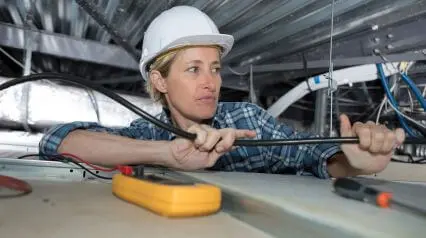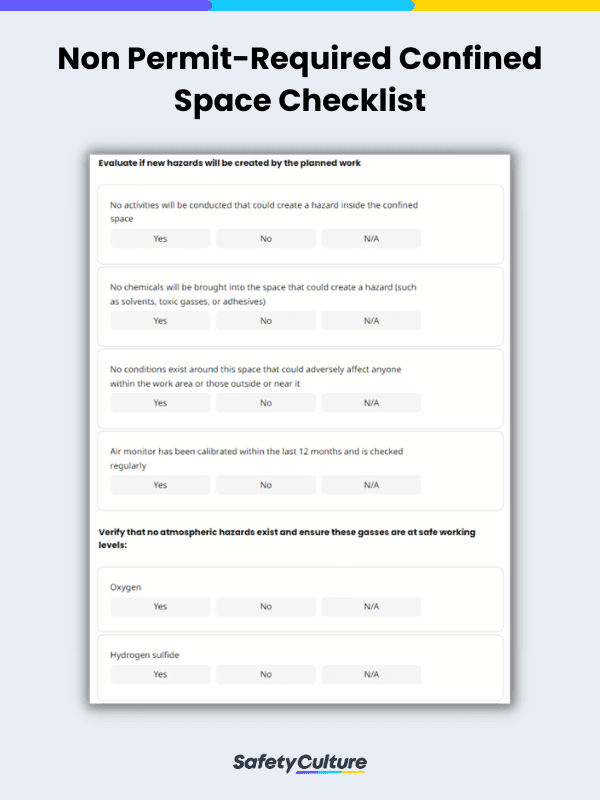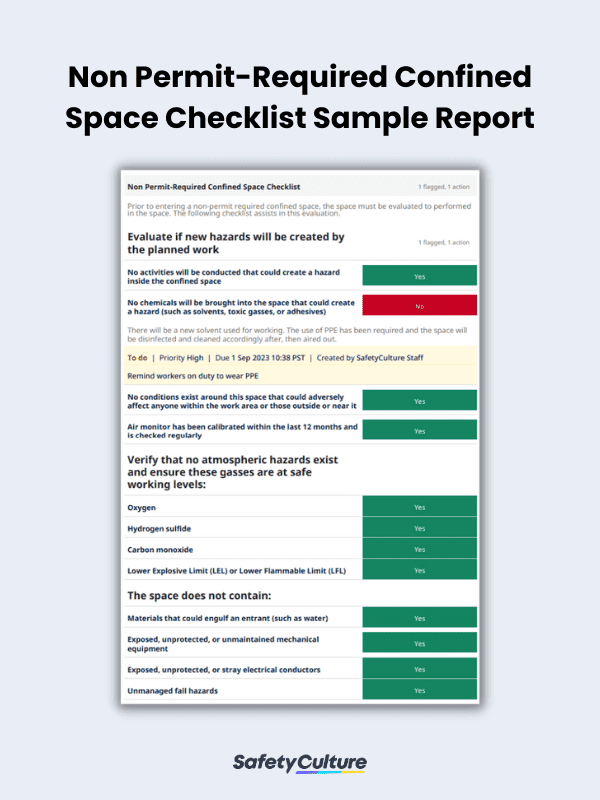What is a Non Permit-Required Confined Space Checklist?
A non permit-required confined space checklist is for entering or working in a confined space that does not contain hazards that can cause serious harm or death. It aims to mitigate risks and ensure the safety of workers in confined spaces.
What is a Non Permit-Required Confined Space?
According to the US Occupational Safety and Health Administration (OSHA), a non-permit confined space is any confined space that is not likely to cause harm to workers through atmospheric, mechanical, fire, or gaseous hazards. It is a place where hazards are “eliminated” enough to cause little to no risk to humans.
However, it’s important to note that even in non permit-required confined spaces, potential dangers might still exist due to factors such as:
- limited entry and exit points;
- confined movement; and
- the presence or condition of certain work-related machinery.
Employers are still responsible for ensuring that workers receive proper training, are equipped with necessary safety protection, and follow established safety protocols. Regular assessments of the space’s conditions should also be conducted to verify that no unexpected hazards have emerged.
Importance of Using a Checklist for Confined Space Safety
It is important to keep non permit-required confined spaces free from hazards at all times, as changes in the amount and kinds of hazards will require employers to reevaluate that space. A non permit-required confined space checklist is essential in keeping said space in a safe working condition.
With a dedicated checklist, you can ensure that all risk is eliminated at all times and that any hazards that may come up are dealt with accordingly immediately. Should an incident occur, the checklist provides a documented record of the safety measures that were followed, aiding in investigations and potential improvements to the safety protocols.
Additionally, by standardizing procedures through the checklist, there is consistency in the safety measures taken across different non permit-required confined spaces. In the process, it also helps in training and educating employees on the proper procedures and precautions to take when entering confined spaces, ensuring that there is no ambiguity in safety expectations. As a result, the risk of accidents is significantly reduced.
Furthermore, the checklist promotes and improves both compliance and accountability. Responsible individuals can verify that each step has been completed before granting entry, minimizing the chances of errors that could lead to accidents or injuries. At the same time, this ensures compliance with safety guidelines set by the employer, the area’s safety professionals, and international standards.
What to Include in a Non Permit-Required Confined Space Checklist
To ensure your non permit-required confined space is safe for use and work, create a checklist that includes fields for the following:
- Evaluating if any new hazards will be introduced to the confined space from:
- Work tasks
- Chemicals
- Equipment
- Air monitors
- Ensuring gasses such as the following are at safe working levels
- Oxygen
- Hydrogen sulfide
- Carbon monoxide
- Lower Explosive Limit (LEL) or Lower Flammable Limit (LFL)
- Making sure the following are not present or are controlled so as to not cause harm or create other hazards:
- Materials that can engulf different items
- Exposed or unmaintained equipment
- Stray electrical equipment
- Unmanaged fall hazards
- Asbestos or asbestos-generating materials
Here is a sample non permit-required confined space checklist in use for reference:
FAQs about Non Permit-Required Confined Space Checklists
A checklist for a non permit-required confined space is focused on ensuring there are no hazards in a set confined space. If there are any hazards, the next step would be to remove them or mitigate them.
On the other hand, a permit-required confined space has more hazards involved, thus requiring a different checklist. The checklist for this kind of confined space often has more items to consider and more safety precautions involved.
The most common examples of a non permit-required confined space include:
- Closets such as equipment closets
- Crawl spaces under buildings
- Machinery cabinets
- Ventilated tunnels
It is the responsibility of employers to manage non permit-required confined spaces and their respective checklists. In some cases, however, it can be done by a safety manager or a specific department head.




